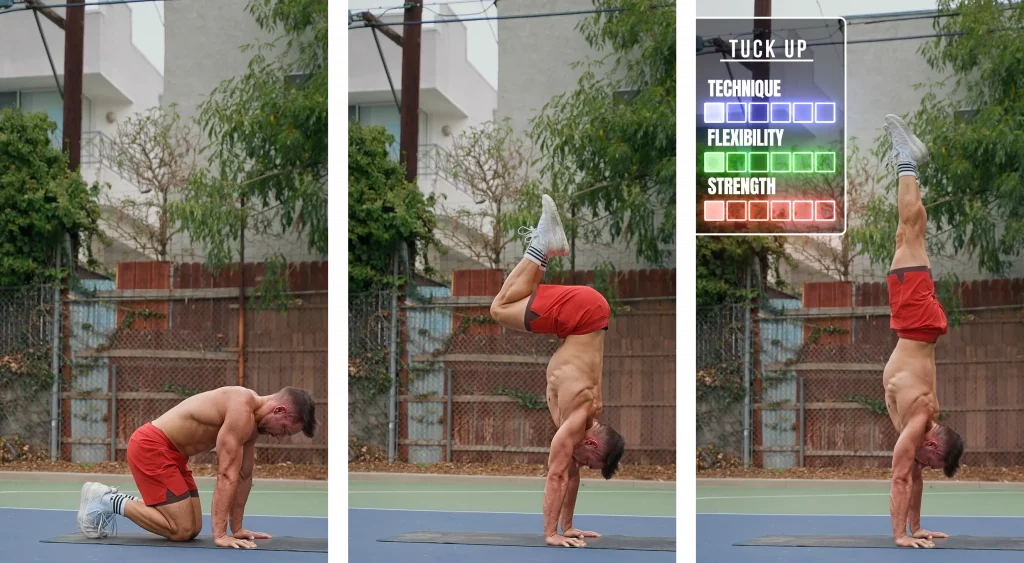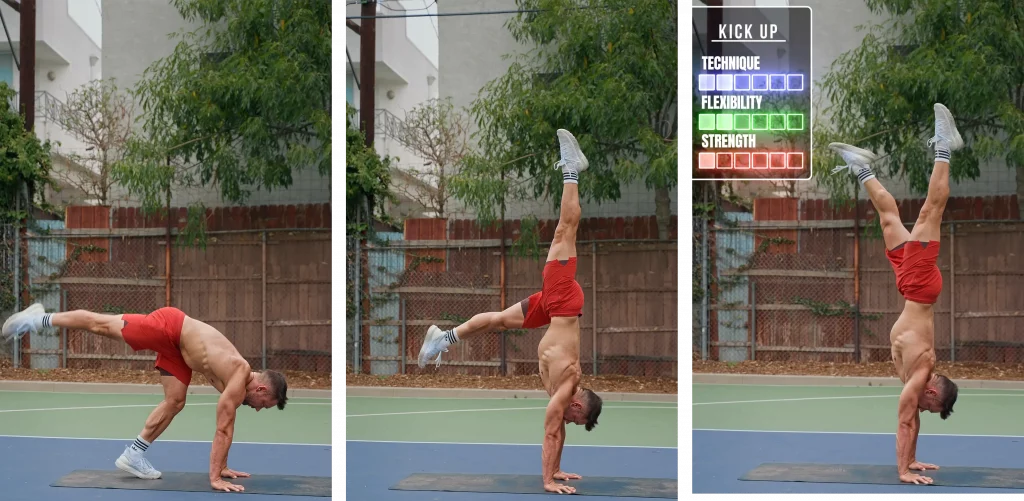The Problem with Handstands lies in the mount
If you ever had the chance of training with a coach who is able to give you a good spot you might have realized that if placed in the right position you can hold your handstand. This fact is true for beginners who are trying to get their first freestanding handstand but especially for more advanced athletes who are learning to one arm handstand.
Finding this perfect position where you have control is what is actually difficult. Once there it is usually smooth sailing until you lose this “perfect” position.
Now in order to get to this position we also have to invert. We have to get the hips and legs on top of the hands. Depending on how tall you are this can be a long way.
So when we get up into a handstand we first have to bring our legs up and then even fight to get into the position where we have control. 1 alone is hard. Both at the same time is very difficult making mounts probably the most difficult part of anyone learning to handstand.
Different types
of mounts
There are basically 2 different types of mounts. The main difference between mounts is if you stay in control the entire time or not. In other words if you jump up and use momentum to get up or if you press up staying in full control the entire time.
Mounts with blind spot
Almost all beginners have to learn jumping handstand mounts first. These require significantly less from the athlete. Dynamic mounts usually do not need a lot of strength or flexibility and are not super technical. They do however require quite a bit of coordination which can often only be developed by practicing the precise movement. Dynamic mounts can also be scarier as you have to jump on your hands.
The big issue with jumping handstand mounts is that you lose control for a moment. Between the moment that your feet leave the floor and the moment when you actually take control of your handstand you are not in control of the movement. You push off the floor with your feet and all you can do is hope for the best. Consequently these mounts will almost never be 100% consistent as you are always guessing a bit.
Full control mounts
Any mount where you are pressing up into the handstand is significantly harder as your handstand has to be pretty good, they are often very technical and you need either decent amounts of strength or flexibility.
The big advantage of these kinds of mounts is that you stay in control the entire time. Everything is up to you and nothing is left for chance. This means that if prepared correctly and trained consistently these mounts can become 100% consistent.
Popular mount
by type
Whilst there are far too many mounts to discuss here and the only limiting factor to coming up with even more mounts is your creativity I want to highlight the most popular mounts here to point out advantages and difficulties in each.
Dynamic Mounts
Anything where you use momentum to get into the handstand is going to be referred to as a dynamic mount. The advantage is that these are easier than presses. The big disadvantage is that you have to push through the blind spot explained above.
Tuck Up to Handstand
The tuck up is the most beginner friendly mount there is. Almost everyone will learn this one before anything else. Use the tuck position as a stepping stone to align your hips with the already aligned shoulders and hands and start with as much weight as possible in your hands at the beginning of the movement.

Straddle Jump to Handstand
Straddle Jumps just like tuck ups are very beginner friendly. Whilst technique is very similar to the tuck up the straddle up requires more hip mobility and becomes significantly easier with more available pancake and middle split flexibility.
Kick Up to Handstand
The Kick Up to Handstand is possibly the most popular handstand entry and at the same time probably the most underestimated one. Most people believe the kick up is simple and beginner friendly and whilst a beginner can surely make it up to a handstand this way getting consistent and stable is difficult. The kick up to handstand is quite technical, requires higher amounts of hamstring flexibility than other mounts and presents lots of room for error.

Presses to Handstand
Whilst more difficult as the athlete needs to be stronger, more coordinated and more flexible presses to handstand come with the significant advantage that one can stay in control the entire time making these the perfect entrances for when you really want to be sure you make it up.
Straddle Press to Handstand
The straddle press to handstand is the go to for most advanced handstand athletes. It represents a major milestone in any handstand journey and when executed with correct form the press to handstand requires not much energy and is perfectly stable.

Pike Press to Handstand
The Pike Press to Handstand is quite a bit heavier than the straddle press to handstand as the athlete can not take advantage of a deep middle split. Since you are forced to keep your legs together your center of gravity will be further out and you will have to lift more of your own weight.
Stalder & L Sit Press
The stalder and L Sit Press to handstand is basically the same thing as the Straddle and Pike Press to Handstand, just significantly harder. You will need to develop improved technique, more strength and more flexibility. The big advantage here is that you do not need to have your feet on the floor during take off and you will therefore be able to perform these mounts almost everywhere.
Bent Arm Press from Standing
The Bent Arm Press is a handstand push up based mount that requires significantly less technique and flexibility yet much more strength than the previously discussed mounts. Whilst it is still easier than a full freestanding handstand push up the athlete should be able to perform at least back to wall handstand push ups in order to be able to perform the bent arm press clean. This mount is a great option for anyone who wants to get up into the handstand consistently without leaving anything up to chance and who does not have very flexible hamstrings.

Which mount
is right for you
Figuring out how you should get up into the handstand is going to depend on 3 things: What is your current handstand level, how strong and how flexible you are. Some mounts are more suitable for other athletes and everyone has their personal preferences. Start with whichever works best for you and over the years train to master them all.
Beginner
The beginners worry should not be how to get up but to be up. I can not stress enough that instead of focusing on your mounts you should cut them out entirely for now. Go to the wall and work with wall takeoffs and slide aways. Mounts are unrealistically hard when first learning to handstand. First get very good close to the wall. Then slowly start to incorporate tuck ups. The better you get at handstands the less precise your mount has to be. Any time spend on making your mounts perfect enough to hold a mediocre handstand is wasted as your handstands will improve and soon your mount doesn’t need to be perfect anymore
Intermediate
Mounts are definitely a big focus point of the intermediate handstand athlete. The main focus is not anymore on holding a handstand. We are able to do this. It is not as interesting anymore. Now the focus lies in making the regular handstand efficient and consistent in order to focus on more advanced drills. If only 2 out of 5 mounts work you are wasting time and energy and won’t be able to progress at any desired speed.
Tuck up, straddle jumps to handstand and if flexibility allows it even kick ups to handstand should be part of your daily training until 9 out of 10 are stable.
It is also time to start working very seriously towards the press to handstand
Advanced
A regular handstand is nothing special or exciting for the advanced handstand athlete. Hollow backs, one arm handstands and similar drills are part of your regular workout plan. Getting into the handstand shouldn’t even be something you’re even thinking about at this point. The go to mount for most advanced athletes is the press to handstand or the jumping press to handstand to save energy. If you are training on a higher surface or you have super tight hamstrings you might stick to simple tuck jumps to handstands or bent arm presses.
Handstand mounts are fun. Handstand mounts can bring variety to training and performance but handstand mounts are also complicated and need to be trained separately as specific skills. Being efficient and consistent in your handstand entries is necessary in order to train more advanced skills as you can not expect to move forward with your handstand technique if you spend time and energy on every single mount.







